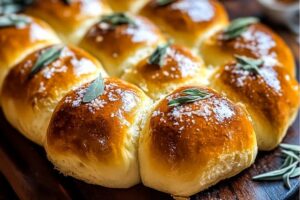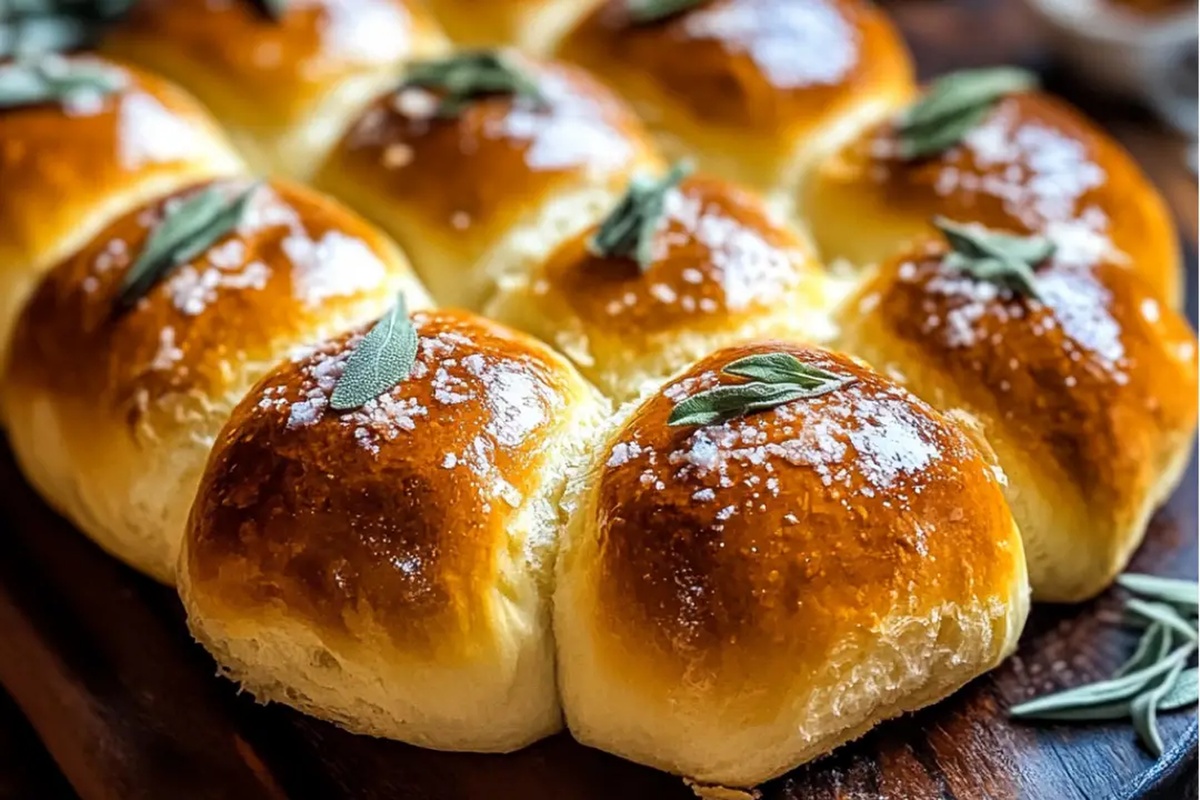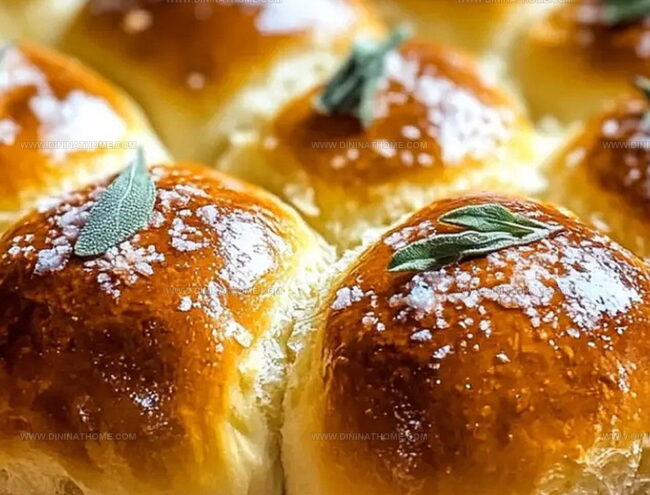Warm Salted Sage Honey Butter Brioche Rolls Recipe for Fall
Crafting salted sage honey butter brioche rolls brings magical moments to any kitchen gathering.
Fragrant sage leaves whisper culinary secrets into soft, pillowy dough.
Butter melts luxuriously, creating golden-edged perfection that beckons hungry souls.
Sweet honey adds unexpected depth to each tender bite.
Warm spices dance through delicate layers, promising comfort in every morsel.
Delightful aromas will float through your home, drawing everyone near the table.
Baking these rolls becomes a delicious adventure you won’t want to miss.
Why Salted Sage Honey Butter Brioche Rolls Are So Good
What Goes Into Salted Sage Honey Butter Brioche Rolls
Dough Ingredients:Liquid and Fat Ingredients:Sage Honey Butter Topping Ingredients:Additional Finishing Ingredients:Honey Butter Brioche Roll Baking Instructions
Step 1: Mixing the Dough
In a stand mixer bowl, combine flour, yeast, and salt.
Pour in warm milk, honey, eggs, and butter.
Use the dough hook to blend everything together for 4-5 minutes until the mixture becomes smooth and cohesive.
If the dough feels sticky, gradually add extra flour to achieve the right consistency.
Let the dough rest at room temperature for 15-60 minutes, allowing the flavors to develop and the yeast to work its magic.
Step 2: Creating Sage Honey Butter
Heat a skillet over medium flame.
Fry sage leaves in butter until they turn crispy and fragrant.
Remove the leaves and chop them finely.
In a small mixing bowl, combine:Blend the ingredients until they form a rich, aromatic spread.
Step 3: Shaping the Rolls
Preheat the oven to 350°F.
Line a 9×9-inch baking dish with parchment paper.
Gently deflate the rested dough and divide it into two equal portions.
On a lightly floured surface, roll each portion into a 12-inch square, aiming for a 1/4-inch thickness.
Generously brush the squares with the prepared sage honey butter, reserving some for later.
Slice each square into 6 strips.
Carefully roll each strip into a delicate coil and place them seam-side down in the prepared baking dish.
Step 4: Letting the Rolls Rise
Brush the shaped rolls with beaten egg yolk.
Cover the dish and allow the rolls to rise for 30 minutes, or until they become puffy and almost doubled in size.
Step 5: Baking and Finishing
Slide the baking dish into the preheated oven.
Bake for 22-25 minutes, watching for a beautiful golden-brown color.
Once baked, remove from the oven and immediately brush with the remaining sage honey butter.
Sprinkle with flaky sea salt for an extra touch of flavor.
Serve these heavenly rolls warm and enjoy the incredible blend of herbs, sweetness, and buttery goodness.
Holiday Dinner Rolls with Sage Butter Tips
Swap all-purpose flour with whole wheat or gluten-free flour blend for different dietary needs, ensuring the same delicious results.
Replace fresh sage with dried sage or other herbs like rosemary or thyme if fresh isn’t available, maintaining the aromatic flavor profile.
Keep the dough slightly sticky for softer, more tender rolls – resist adding too much flour during mixing.
Allow longer room temperature proofing for deeper flavor development, up to an hour instead of just 15 minutes.
Use high-quality unsalted butter for better control of salt content and richer taste in both dough and sage honey butter.
Chill Salted Sage Butter Brioche Rolls
Tasty Matches for Honey Butter Brioche Rolls
Brioche Rolls Topping or Filling Variations
FAQs
A stand mixer with a dough hook helps develop gluten and creates a smoother, more elastic dough with less manual kneading, ensuring the brioche has a soft, tender texture.
Yes, you can prepare the dough in advance and refrigerate it overnight. Just let it come to room temperature and rise before shaping and baking the rolls.
If the dough feels sticky, gradually add flour 1/4 cup at a time while mixing. The goal is a smooth, slightly tacky dough that doesn’t stick to your hands.
The rolls are ready when they look puffy and have nearly doubled in size, typically after about 30 minutes of rising. They should look soft and slightly swollen before baking.
Print
Salted Sage Honey Butter Brioche Rolls Recipe
- Total Time: 50 minutes
- Yield: 12 1x
Description
Rustic salted sage honey butter brioche rolls offer a delightful blend of herbaceous and sweet flavors that dance across your palate. Rich, golden-brown rolls emerge from the oven, promising a luxurious experience you’ll savor with each tender, aromatic bite.
Ingredients
Main Ingredients:
- 3 1/4 cups (780 ml) all-purpose flour
- 3 whole eggs, at room temperature
- 6 tablespoons (90 grams) salted butter, at room temperature
- 3/4 cup (180 ml) warm milk
- 1 packet (2 1/4 teaspoons) instant yeast
Seasoning and Flavoring Ingredients:
- 1 teaspoon salt
- 3 tablespoons honey
- 12 sage leaves
- Flaky sea salt, for topping
Additional Ingredients:
- 1 egg yolk, beaten with 1 tablespoon water
- 6 tablespoons (90 grams) salted butter, at room temperature (for sage honey butter)
- 3 tablespoons honey (for sage honey butter)
Instructions
- Craft the foundational dough by combining dry ingredients in a stand mixer’s bowl, creating a smooth base for the brioche rolls.
- Integrate warm milk, honey, eggs, and butter into the flour mixture, using the dough hook to knead until a cohesive, silky texture emerges.
- Allow the dough to rest and develop at room temperature, enabling fermentation and flavor enhancement.
- Prepare the aromatic sage honey butter by gently frying sage leaves in butter until they become delicately crisp and fragrant.
- Blend the remaining butter with honey, chopped sage leaves, and a whisper of sea salt to create a luxurious, herbaceous spread.
- Preheat the oven and prepare a baking dish with parchment paper, setting the stage for golden, pillowy rolls.
- Deflate the rested dough and divide into two portions, rolling each into thin, expansive squares on a lightly floured surface.
- Generously coat the dough squares with the sage-infused honey butter, reserving some for the final glaze.
- Slice each square into six distinct strips, then elegantly coil each strip into a compact roll, nestling them seam-side down in the prepared baking dish.
- Brush the rolls with beaten egg yolk to ensure a glossy, rich exterior during baking.
- Allow the rolls to rise and become puffy, developing their characteristic soft, airy texture.
- Bake until the rolls transform into a golden-brown masterpiece with enticing, crisp edges.
- Immediately after removing from the oven, lavish the rolls with the remaining sage honey butter.
- Finish with a delicate sprinkle of flaky sea salt, elevating the rolls’ flavor profile and visual appeal.
Notes
- Customize the dough’s hydration by adjusting flour gradually to achieve the perfect soft and pillowy texture for your brioche rolls.
- Transform this recipe into a gluten-free version by substituting all-purpose flour with a blend of gluten-free flour and xanthan gum for similar elastic properties.
- Create a vegan alternative by replacing eggs with aquafaba and using plant-based butter to maintain the rich, tender crumb characteristic of brioche.
- Enhance meal prep efficiency by preparing the sage honey butter and dough a day ahead, allowing the flavors to develop and saving time during final preparation.
- Prep Time: 25 minutes
- Cook Time: 25 minutes
- Category: Breakfast, Snacks, Dinner
- Method: Baking
- Cuisine: American
Nutrition
- Serving Size: 12
- Calories: 250
- Sugar: 6 g
- Sodium: 200 mg
- Fat: 14 g
- Saturated Fat: 8 g
- Unsaturated Fat: 5 g
- Trans Fat: 0 g
- Carbohydrates: 28 g
- Fiber: 1 g
- Protein: 4 g
- Cholesterol: 70 mg




James Walker
Lead Recipe Developer & Culinary Educator
Expertise
Southern Cuisine & Farm-to-Table Cooking, Recipe Development & Testing, Culinary Education & Instruction
Education
School: Auguste Escoffier School of Culinary Arts
Program: Diploma in Culinary Arts and Operations
Focus: Comprehensive training in classical and modern culinary techniques, kitchen operations, and farm-to-table practices.
James didn’t learn cooking from a TV show, he learned it from busy kitchens, family gatherings, and long afternoons spent testing recipes the hard way.
After training at the Auguste Escoffier School of Culinary Arts, he brought his love for real, down-to-earth food to every dish he makes.
At Dining At Home, James loves building recipes that feel familiar but still have something special, like adding a twist to a classic or making a slow Sunday dinner feel brand new.
When he’s not in the kitchen, you’ll probably find him swapping garden tips at the farmers’ market or teaching his daughter how to flip pancakes without a mess (almost).